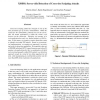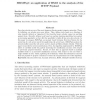123 search results - page 2 / 25 » A Lightweight Tool for Detecting Web Server Attacks |
ACSAC
2008
IEEE
13 years 11 months ago
2008
IEEE
Cross-site Scripting (XSS) has emerged to one of the most prevalent type of security vulnerabilities. While the reason for the vulnerability primarily lies on the serverside, the ...
ACSAC
2004
IEEE
13 years 9 months ago
2004
IEEE
Host security is achieved by securing both the operating system kernel and the privileged applications that run on top of it. Application-level bugs are more frequent than kernel-...
JMLR
2010
13 years 3 days ago
2010
Zero-days attacks are one of the most dangerous threats against computer networks. These, by definition, are attacks never seen before. Thus, defense tools based on a database of ...
CCS
2004
ACM
13 years 10 months ago
2004
ACM
As network security is a growing concern, system administrators lock down their networks by closing inbound ports and only allowing outbound communication over selected protocols ...
CCS
2010
ACM
13 years 4 months ago
2010
ACM
Web applications rely heavily on client-side computation to examine and validate form inputs that are supplied by a user (e.g., “credit card expiration date must be valid”). T...



